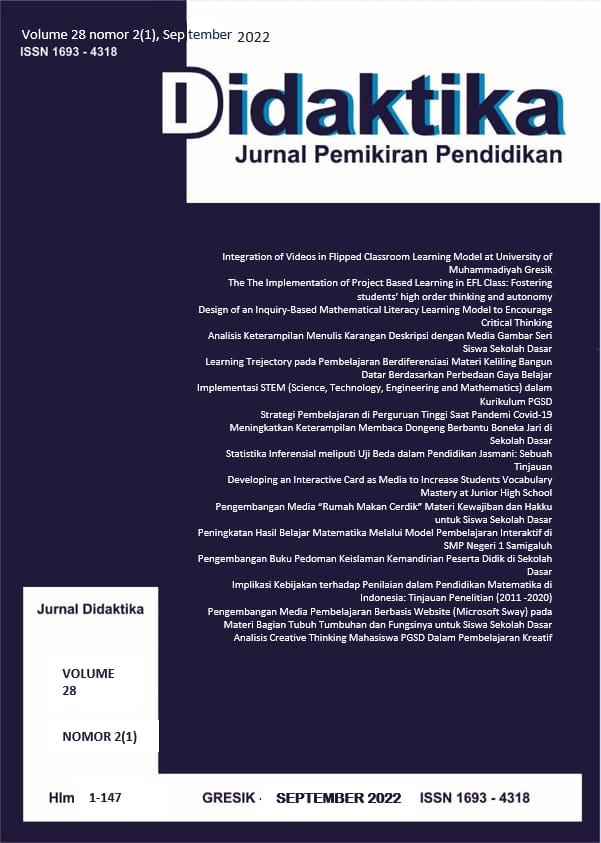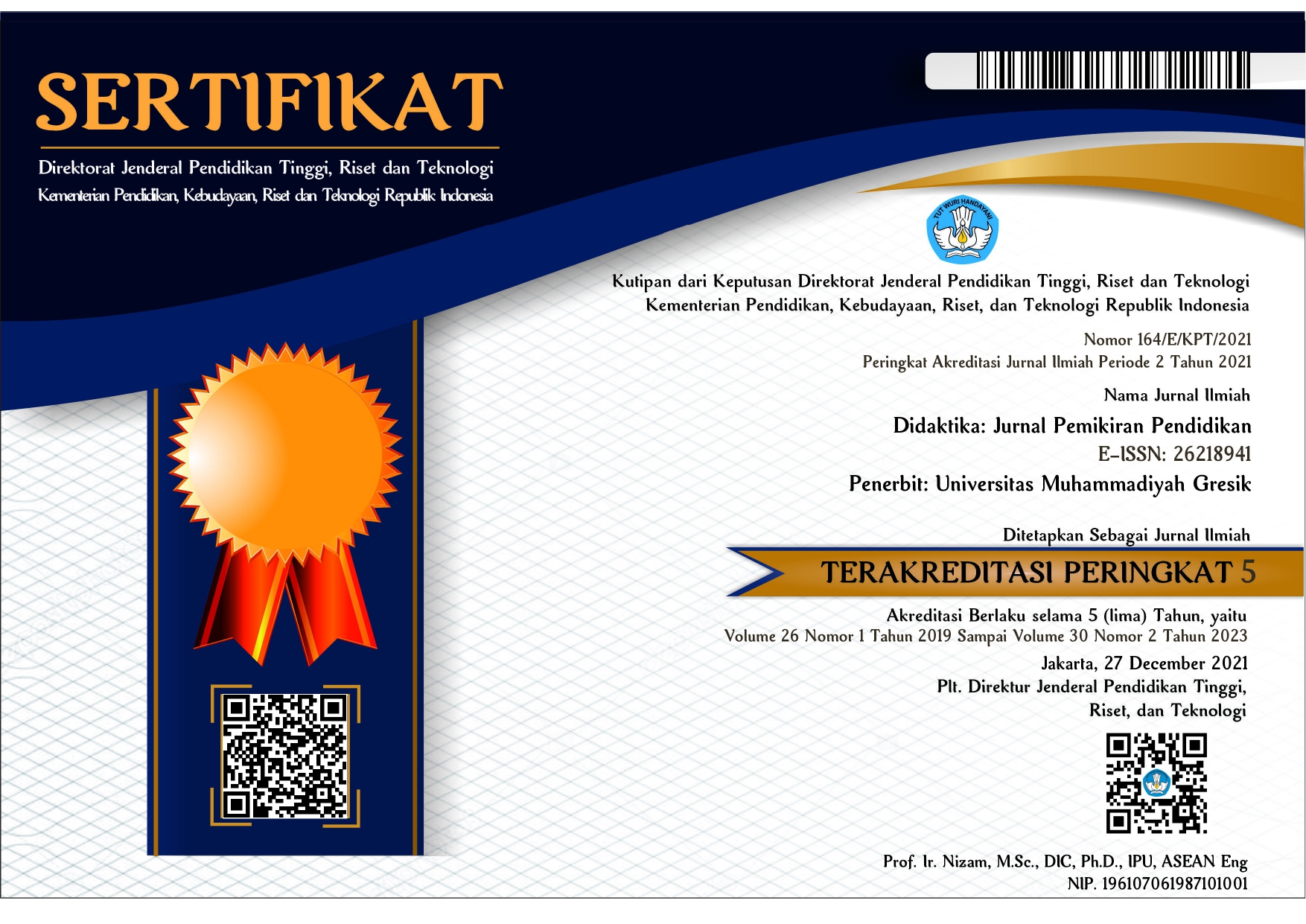The The Implementation of Project Based Learning in EFL Class: Fostering students’ high order thinking and autonomy
Fostering students’ High order thinking and autonomy
DOI:
https://doi.org/10.30587/didaktika.v28i2.4405Keywords:
HOTS, Learning Autonomy, Project Based LearningAbstract
High Order Thinking Skills (HOTS) and Autonomy should be an integral part of the teaching and learning process, particularly at the university level to foster students’ critical thinking, creative thinking, and learning autonomy to form a habit as lifelong learners. This is a habit that should be designed not only for assessment purposes, but also for the implementation during classroom teaching process. The purpose of this study is analysed students’ HOTS and learning autonomy for English department students in EFL class to design lesson plan by the implementation of Project Based Learning. Three cognitive domains used as parameters to identify students’ HOTS: analysing, evaluating, and creating, while learning autonomy was portrayed through five aspects as the indicators: determining the objectives, setting the plan, selecting methods and techniques, reflect on learning, and assessing and evaluating the project. This study used mixed method in which three observations were made during the teaching learning process, and questionnaires were distributed to 33 English department students in EFL class. In addition, students were chosen using snowball method and interviewed. Both quantitative and qualitative approach were used to analyse the data. The discovery revealed that indicators and characteristics of HOTS and learning autonomy were presented in a consistent manner during classroom interaction and accomplishing project outside the classroom. Students frequently demonstrate critical and creative thinking in variety of ways when they were participating in the classroom. While learning autonomy portrayed on every stage of accomplishing the project to design lesson plan. The implementation of project-based learning is extremely effective and contribute significantly to foster students’ HOT and autonomy.
References
Anderson, L. W., Krathwohl, D. R., Airasian, P. W., Cruikshank, K. A., Mayer, R. E., Pintrich, P. R., Raths, J., & Wittrock, M. C. (2001). Taxonomy for Learning,Teaching and assessing. https://www.pdfdrive.com/a-taxonomy-for-learning-teaching-and-assessing-a-revision-of-blooms-taxonomy-of-educational-objectives-d187836328.html
Ansori, M. (2019). English Teachers’ Efficacy in Using Pedagogical Techniques To Promote Higher Order Thinking Skills. Celtic: A Journal of Culture, English Language Teaching, Literature and Linguistics, 6(2), 1–13. https://doi.org/10.22219/celtic.v6i2.9860
Asari, S., Husniah, R., Ma’rifah, U., & Anwar, K. (2019). Fostering Students’ High Order Thinking Skills through the Use of Interpretation Cards. International Journal of Education and Literacy Studies, 7(4), 17. https://doi.org/10.7575/aiac.ijels.v.7n.4p.17
Benson, Phil; Reinders, H. (2011). Beyond the Language Classroom. PALGRAVE MACMILLAN.
Borg, S., Al-busaidi, S., & Centre, T. L. (2019). Learner Autonomy : English Language Teachers ’ Beliefs and Practices Learner Autonomy : English Language Teachers ’ Beliefs and Practices. ELT Reseach Paper, 07(12).
Chinn, C. A. (2011). EDucational Psychology: Understanding Students’ Thinking. In Rutgers University. https://doi.org/10.5617/adno.2437
Condliffe, B., Quint, J., Visher, M. G., Bangser, M. R., Drohojowska, S., Saco, L., & Nelson, E. (2017). Project-Based Learning: A Literature Review. Mdrc, October, 1–84.
Eyring, J. L. (1997). Is project work worth it? In Ashington, DC: Education Resources Information Center: ERIC Database.
Fakhomah, D. N., & Utami, M. S. (2019). Pre-Service English Teacher Perception About Higher Order Thinking Skills (HOTS) in the 21st Century Learning. International Journal of Indonesian Education and Teaching, 3(1), 41–49. http://e-journal.usd.ac.id/index.php/IJIET
Fitriana, N. (2019). Penerapan Model Pembelajaran Project Based Learning untuk meningkatkan kemampuan belajar siswa melalui kegiatan kolaborasi mata pelajaran bahasa inggris di SMP Negeri 6 batam. Daiwi Widya Jurnal Pendidikan, 5(2), 87–92.
Guo, P., Saab, N., Post, L. S., & Admiraal, W. (2020). A review of project-based learning in higher education: Student outcomes and measures. International Journal of Educational Research, 102(April), 101586. https://doi.org/10.1016/j.ijer.2020.101586
Kimsesiz, F., Dolgunzos, E., & Konca, M. Y. (2017). The effect of Poject based learning in Teaching EFL vocabulary to young learners of English: the case of Pre-School Children. International Journal of Languages’ Education and Teaching, 5(4), 426–439. http://files.eric.ed.gov/fulltext/ED581572.pdf
Knowles, M. (1975). Self directed learning a guide for learners and teachers. Follett Publising Company/Chicago.
Lai, C. (2019). Learning beliefs and autonomous language learning with technology beyond the classroom. Language Awareness, 28(4), 291–309. https://doi.org/10.1080/09658416.2019.1675679
Lai, C., & Gu, M. (2011). Self-regulated out-of-class language learning with technology. Computer Assisted Language Learning, 24(4), 317–335. https://doi.org/10.1080/09588221.2011.568417
Laur, D. (2013). Authentic Learning Experience A Real-World Approach to Project-Based Learning. In Eye On Education Routledge (Vol. 53, Issue 9).
Mukhlifida, N. (2021). meningkatkan hasil belajar bahasa inggris pada ketrampilan speaking materi monolog descriptive lisan sederhana yang berterima melalui model project based learning. Jurnal Inovasi Pendidikan Dan Pengajaran, 1(1), 36–44.
Phasuk, P., Prabjandee, D., & Surasin, J. (2019). and education Preservice Teacher Fostering Learner Autonomy in an English Preservice Teacher ’ s s Pedagogical Pedagogical Content in Classroom by Using Project-Based Learning Content Knowledge Knowledge in Lesson Lesson Study Study l l a a c c i i g g o. HRD Journal, 10(1), 33–45.
Pratiwi, T., Marsidin, S., Syarif, H., & Yahya. (2020). The Effectiveness of the Directed – Project Based Learning Model in Improving the Learning Outcomes of Class VIII Students at Junior High School. The Second International Conference Innovation, 504(ICoIE), 365–369. https://doi.org/10.2991/assehr.k.201209.250
QEP. (2014). Higher-order Skills in Critical and Creative Thinking (Issue January).
R, R. B., & Nagehan, Y. (2015). Autonomous foreign language learning. Journal of Languages and Culture, 6(8), 71–79. https://doi.org/10.5897/jlc2015.0338
Reinders, H. (2010). Towards a Classroom Pedagogy for Learner Autonomy. Australian Journal of Teacher Education, 35(5), 40–55.
Sumarni, W., Wardani, S., Sudarmin, S., & Gupitasari, D. N. (2016). Project based learning (PBL) to improve psychomotoric skills: A classroom action research. Jurnal Pendidikan IPA Indonesia, 5(2), 157–163. https://doi.org/10.15294/jpii.v5i2.4402
Sumarni, Woro. (2015). The Strenghths and Weaknesess of the Implementation of Project Based Learning: A Review. International Journal of Science and Research (IJSR), 4(3), 478–484. https://www.ijsr.net/archive/v4i3/SUB152023.pdf
Syamsul Arif, Basyaruddin, & Achmad Yuhdi. (2020). Integration of High Order Thinking Skills in Research Method Subject in University. Britain International of Linguistics Arts and Education (BIoLAE) Journal, 2(1), 378–383. https://doi.org/10.33258/biolae.v2i1.207
Sydoruk, P. D. (2018). An Analysis of the Higher Order Thinking Requirements of a Grade 8 Online-Based English Language Arts Skills Program. ProQuest Dissertations and Theses, 148. http://ezproxy.library.unlv.edu/login?url=https://www.proquest.com/dissertations-theses/analysis-higher-order-thinking-requirements-grade/docview/2031604442/se-2?accountid=3611%0Ahttp://unlv-primo.hosted.exlibrisgroup.com/openurl/01UNLV/01UNLV_SP??url_ver=Z
Sykes, J. M. (2018). Digital games and language teaching and learning. Foreign Language Annals, 51(1), 219–224. https://doi.org/10.1111/flan.12325
Tiantong, M., & Siksen, S. (2013). The Online Project-based Learning Model Based on Students’ Multiple intelligence. International Journal of Humanities and Social Sciemce, 3(7), 53–72. https://doi.org/10.2217/EBO.13.11
Wijayati, N., Sumarni, W., & Supanti, S. (2019). Improving Student Creative Thinking Skills Through Project Based Learning. KnE Social Sciences, 2019, 408–421. https://doi.org/10.18502/kss.v3i18.4732
Woolfolk, A. (2017). Anita Woolfolk - Educational Psychology-Pearson International (2016) (Issue December).
Yeh, Y. L., & Lan, Y. J. (2018). Fostering student autonomy in English learning through creations in a 3D virtual world. Educational Technology Research and Development, 66(3), 693–708. https://doi.org/10.1007/s11423-017-9566-6
Yuliansyah, A., & Ayu, M. (2021). The Implementation of Project-Based Assignment in Online Learning during Covid-19. Journal of English Language Teaching and Learning (JELTL), 2(1), 32–38. http://jim.teknokrat.ac.id/index.php/english-language-teaching/index
Downloads
Published
How to Cite
Issue
Section
License
License and Copyright Agreement
In submitting the manuscript to the journal, the authors certify that:
- They are authorized by their co-authors to enter into these arrangements.
- The work described has not been formally published before, except in the form of an abstract or as part of a published lecture, review, thesis, or overlay journal.
- That it is not under consideration for publication elsewhere,
- That its publication has been approved by all the author(s) and by the responsible authorities – tacitly or explicitly – of the institutes where the work has been carried out.
- They secure the right to reproduce any material that has already been published or copyrighted elsewhere.
- They agree to the following license and copyright agreement.
Copyright
Authors who publish with DIDAKTIKA: Jurnal Pemikiran Pendidikan agree to the following terms:
- Authors retain copyright and grant the journal right of first publication with the work simultaneously licensed under a Creative Commons Attribution License (CC BY-SA 4.0) that allows others to share the work with an acknowledgment of the work's authorship and initial publication in this journal.
- Authors are able to enter into separate, additional contractual arrangements for the non-exclusive distribution of the journal's published version of the work (e.g., post it to an institutional repository or publish it in a book), with an acknowledgment of its initial publication in this journal.
- Authors are permitted and encouraged to post their work online (e.g., in institutional repositories or on their website) prior to and during the submission process, as it can lead to productive exchanges, as well as earlier and greater citation of published work.
Licensing for Data Publication
Open Data and Software Publishing and Sharing
The journal strives to maximize the replicability of the research published in it. Authors are thus required to share all data, code or protocols underlying the research reported in their articles. Exceptions are permitted but have to be justified in a written public statement accompanying the article.
Datasets and software should be deposited and permanently archived inappropriate, trusted, general, or domain-specific repositories (please consult http://service.re3data.org and/or software repositories such as GitHub, GitLab, Bioinformatics.org, or equivalent). The associated persistent identifiers (e.g. DOI, or others) of the dataset(s) must be included in the data or software resources section of the article. Reference(s) to datasets and software should also be included in the reference list of the article with DOIs (where available). Where no domain-specific data repository exists, authors should deposit their datasets in a general repository such as ZENODO, Dryad, Dataverse, or others.
Small data may also be published as data files or packages supplementary to a research article, however, the authors should prefer in all cases a deposition in data repositories.











